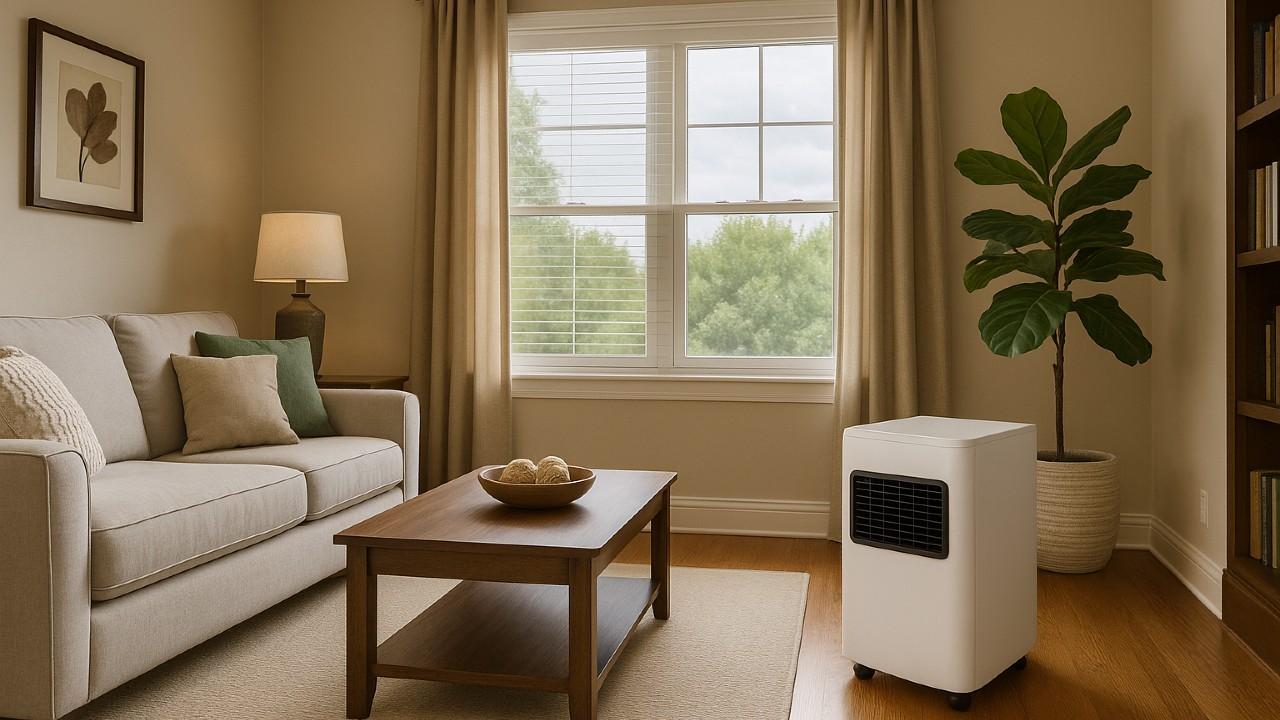Discover the benefits of a whole house dehumidifier for healthier air and year-round comfort in Houston. Learn how it improves air quality and efficiency.

Houston’s humidity is no secret. Even when your air conditioner is running, the air indoors can still feel sticky or damp. A whole house dehumidifier works alongside your HVAC system to remove excess moisture from the air throughout your entire home. It’s different from portable units that only treat one room — this system connects directly to your ductwork to balance humidity levels everywhere.
When humidity rises above 50%, it can cause issues like musty smells, mold growth, and a general feeling of heaviness in the air. By maintaining ideal indoor humidity between 30–50%, a whole house dehumidifier makes your space more comfortable and helps protect your home’s structure, furnishings, and air quality.
A whole house dehumidifier is not just a comfort upgrade — it’s a health and home investment. Below are some of the most important benefits homeowners in the Houston area should know about.
Too much humidity encourages dust mites, mold, and bacteria to thrive. These pollutants can irritate allergies, asthma, and respiratory issues. A whole house dehumidifier removes excess moisture, creating an environment where mold and allergens can’t easily grow.
Better air quality means you breathe easier, especially during Houston’s long, muggy summers. You’ll notice fewer odors and a cleaner feel in your home’s air.
High humidity levels can make walls, ceilings, and even furniture damp. That moisture encourages mold and mildew growth — common causes of allergy flare-ups and structural damage. A whole house dehumidifier keeps humidity in check, reducing these risks significantly.
Mold cleanup is costly and can be dangerous if left untreated. Preventing it with humidity control is far more effective than trying to fix damage after it appears.
Your air conditioner already works hard in Houston’s heat. Excess humidity makes it work even harder, as it must both cool and dehumidify the air. By adding a whole house dehumidifier, you take that strain off your cooling system.
This can extend your AC’s lifespan, improve efficiency, and lower energy costs — all while keeping your home more comfortable.
Learn more about proper AC system maintenance at Champion and Nash AC Maintenance Services.
Humidity problems can creep up slowly, but there are clear warning signs your home could benefit from a whole house dehumidifier.
A persistent musty smell, especially in basements, bathrooms, or closets, is one of the earliest and most noticeable indicators of excessive moisture indoors. These odors are caused by mold spores and bacteria that thrive in damp environments. If the smell doesn’t go away even after cleaning or airing out a room, the humidity levels in your home are likely too high. A whole house dehumidifier tackles this issue at the source by continuously removing moisture from the air, leaving your home fresher and cleaner.
If your windows fog up frequently, it’s a sign that moisture is trapped indoors. Over time, that trapped humidity can lead to visible water droplets forming on the glass and even along window frames. This isn’t just cosmetic — condensation can cause paint to peel, wood trim to warp, and mold to form along sills or behind curtains. When the humidity inside your home is too high, the warm, moist air meets the cooler glass surface, causing water vapor to condense. If this happens regularly, it means the moisture load in your home is beyond what your HVAC system can handle alone. Installing a whole house dehumidifier helps regulate indoor humidity levels, preventing condensation and protecting your windows and frames from long-term damage.
Even when your thermostat says the temperature is comfortable, high humidity can make the air feel sticky or clammy. This happens because humid air prevents sweat from evaporating off your skin, making you feel warmer than you actually are. If you find yourself constantly adjusting the thermostat or using fans just to feel cool, humidity might be the culprit. A whole house dehumidifier removes that excess moisture, restoring natural comfort and helping your air conditioner cool the home more efficiently.
Mold and mildew thrive on moisture. When humidity levels remain high, you may notice dark spots forming on walls, ceilings, or around air vents. Paint can begin to bubble or peel, especially in corners or near windows where moisture tends to accumulate. Beyond the surface damage, this can lead to structural problems and poor indoor air quality. A whole house dehumidifier helps prevent these issues by maintaining humidity levels below 50%, creating an environment where mold can’t survive.
If you or your family experience more coughing, sneezing, or sinus irritation while at home, humidity may be playing a role. Dust mites and mold spores thrive in moist environments and are major triggers for allergies and asthma. By reducing humidity, a whole house dehumidifier decreases these airborne irritants, helping improve respiratory comfort. You’ll likely notice fewer morning sniffles, less eye irritation, and an overall improvement in how fresh the air feels indoors.

A whole house dehumidifier integrates into your HVAC system. Here’s a quick breakdown of the process:
Moist indoor air passes through your home’s return ducts.
The dehumidifier cools the air slightly, condensing water vapor into liquid form.
Collected water is automatically drained, so there’s no tank to empty.
Dry, comfortable air is distributed evenly through your ductwork.
This continuous process keeps your entire home at a consistent and healthy humidity level.
FeatureWhole House DehumidifierPortable DehumidifierCoverageEntire homeOne roomMaintenanceLowFrequent emptying and cleaningEfficiencyHighModerateCostHigher upfront, lower long-termCheaper upfront, less effectiveIntegrationConnects to HVACStandalone
A whole house dehumidifier provides long-term, low-maintenance comfort that portable units can’t match.
Controlling humidity doesn’t just make your home feel better — it can help you save money.
When indoor air is too humid, your AC runs longer to cool the same space. A whole house dehumidifier reduces that load, allowing your system to reach the set temperature faster. That means less energy consumption and lower utility bills.
According to Energy.gov, improving home humidity control can make air conditioning systems operate more efficiently. It’s one of the most effective ways to improve overall home comfort without constantly adjusting your thermostat.
Excess moisture can warp wood floors and furniture. A whole house dehumidifier prevents this damage, preserving your investment.
Even in cooler months, Houston can stay damp. This system keeps humidity balanced no matter the season.
Unlike portable units that buzz constantly, whole house systems operate quietly in the background.
Homes with improved air quality and moisture control appeal more to buyers — a subtle but valuable upgrade.
Learn more about maintaining balanced comfort through AC installation services from Champion and Nash.
For those living in humid areas like Houston, these systems can drastically improve day-to-day comfort and health.
Regular upkeep ensures your whole house dehumidifier continues running efficiently for years.
Dust buildup can reduce airflow and performance. Clean or replace filters every few months.
Make sure the condensate line isn’t clogged to prevent water backups.
Professional inspections help catch issues early and maintain peak efficiency.
Explore professional AC repair options at Champion and Nash AC Repair.
The ideal indoor humidity is between 30–50%. A whole house dehumidifier helps maintain this balance even on extremely humid days. Without one, levels often climb above 60%, leading to musty smells and discomfort.
Yes. Most whole house dehumidifiers are designed to integrate with existing ductwork. An HVAC professional can connect it directly to your air handler, ensuring efficient operation throughout the entire home.
Installation typically ranges from $1,500 to $3,000 depending on your home size and model. While it’s an upfront investment, it reduces long-term repair costs, energy use, and humidity damage — saving money over time.
They run as needed. When humidity levels rise above the set point, the system activates automatically. Once the target level is reached, it cycles off, conserving energy while keeping conditions stable.
Once a year is recommended. Professional maintenance ensures that the drain line, coils, and electrical components are in good condition. Regular service prevents breakdowns and keeps performance optimal.